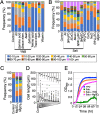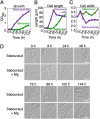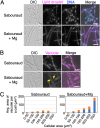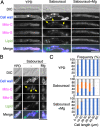Hyphal Growth in Trichosporon asahii Is Accelerated by the Addition of Magnesium
- PMID: 37102973
- PMCID: PMC10269644
- DOI: 10.1128/spectrum.04242-22
Hyphal Growth in Trichosporon asahii Is Accelerated by the Addition of Magnesium
Abstract
Fungal dimorphism involves two morphologies: a unicellular yeast cell and a multicellular hyphal form. Invasion of hyphae into human cells causes severe opportunistic infections. The transition between yeast and hyphal forms is associated with the virulence of fungi; however, the mechanism is poorly understood. Therefore, we aimed to identify factors that induce hyphal growth of Trichosporon asahii, a dimorphic basidiomycete that causes trichosporonosis. T. asahii showed poor growth and formed small cells containing large lipid droplets and fragmented mitochondria when cultivated for 16 h in a nutrient-deficient liquid medium. However, these phenotypes were suppressed via the addition of yeast nitrogen base. When T. asahii cells were cultivated in the presence of different compounds present in the yeast nitrogen base, we found that magnesium sulfate was a key factor for inducing cell elongation, and its addition dramatically restored hyphal growth in T. asahii. In T. asahii hyphae, vacuoles were enlarged, the size of lipid droplets was decreased, and mitochondria were distributed throughout the cell cytoplasm and adjacent to the cell walls. Additionally, hyphal growth was disrupted due to treatment with an actin inhibitor. The actin inhibitor latrunculin A disrupted the mitochondrial distribution even in hyphal cells. Furthermore, magnesium sulfate treatment accelerated hyphal growth in T. asahii for 72 h when the cells were cultivated in a nutrient-deficient liquid medium. Collectively, our results suggest that an increase in magnesium levels triggers the transition from the yeast to hyphal form in T. asahii. These findings will support studies on the pathogenesis of fungi and aid in developing treatments. IMPORTANCE Understanding the mechanism underlying fungal dimorphism is crucial to discern its invasion into human cells. Invasion is caused by the hyphal form rather than the yeast form; therefore, it is important to understand the mechanism of transition from the yeast to hyphal form. To study the transition mechanism, we utilized Trichosporon asahii, a dimorphic basidiomycete that causes severe trichosporonosis since there are fewer studies on T. asahii than on ascomycetes. This study suggests that an increase in Mg2+, the most abundant mineral in living cells, triggers growth of filamentous hyphae and increases the distribution of mitochondria throughout the cell cytoplasm and adjacent to the cell walls in T. asahii. Understanding the mechanism of hyphal growth triggered by Mg2+ increase will provide a model system to explore fungal pathogenicity in the future.
Keywords: Trichosporon asahii; fungal dimorphism; hyphal growth; magnesium.
Conflict of interest statement
The authors declare no conflict of interest.
Figures










Similar articles
-
Analyses of hyphal diversity in Trichosporonales yeasts based on fluorescent microscopic observations.Microbiol Spectr. 2025 Apr;13(4):e0321024. doi: 10.1128/spectrum.03210-24. Epub 2025 Feb 25. Microbiol Spectr. 2025. PMID: 39998240 Free PMC article.
-
Interaction of Host Proteins with Cell Surface Molecules of the Pathogenic Yeast Trichosporon asahii.Med Mycol J. 2023;64(2):29-36. doi: 10.3314/mmj.22-00020. Med Mycol J. 2023. PMID: 37258132
-
Role of arthroconidia in biofilm formation by Trichosporon asahii.Mycoses. 2021 Jan;64(1):42-47. doi: 10.1111/myc.13181. Epub 2020 Sep 23. Mycoses. 2021. PMID: 32918326
-
Strategy to Identify Virulence-Related Genes of the Pathogenic Fungus Trichosporon asahii Using an Efficient Gene-Targeting System.Microbiol Immunol. 2025 Feb;69(2):77-84. doi: 10.1111/1348-0421.13192. Epub 2024 Dec 11. Microbiol Immunol. 2025. PMID: 39660720 Review.
-
Epidemiological study of Trichosporon asahii infections over the past 23 years.Epidemiol Infect. 2020 Jul 24;148:e169. doi: 10.1017/S0950268820001624. Epidemiol Infect. 2020. PMID: 32703332 Free PMC article.
Cited by
-
Hog1-mediated stress tolerance in the pathogenic fungus Trichosporon asahii.Sci Rep. 2023 Aug 19;13(1):13539. doi: 10.1038/s41598-023-40825-y. Sci Rep. 2023. PMID: 37598230 Free PMC article.
-
Comparative transcriptional analysis of Candida auris biofilms following farnesol and tyrosol treatment.Microbiol Spectr. 2024 Apr 2;12(4):e0227823. doi: 10.1128/spectrum.02278-23. Epub 2024 Mar 5. Microbiol Spectr. 2024. PMID: 38440972 Free PMC article.
-
Trichosporon infection in chronic kidney disease patients from a tertiary care hospital - a case series or an outbreak? An unanswered question but a well-managed problem.GMS Infect Dis. 2024 Nov 11;12:Doc05. doi: 10.3205/id000090. eCollection 2024. GMS Infect Dis. 2024. PMID: 39669586 Free PMC article.
-
Analyses of hyphal diversity in Trichosporonales yeasts based on fluorescent microscopic observations.Microbiol Spectr. 2025 Apr;13(4):e0321024. doi: 10.1128/spectrum.03210-24. Epub 2025 Feb 25. Microbiol Spectr. 2025. PMID: 39998240 Free PMC article.
-
Production of Mite-Pathogenic Akanthomyces attenuatus JEF-147 Blastospores in Flask and Bioreactor Conditions.Mycobiology. 2025 Jul 23;53(4):572-583. doi: 10.1080/12298093.2025.2532235. eCollection 2025. Mycobiology. 2025. PMID: 40718139 Free PMC article.
References
Publication types
MeSH terms
Substances
Supplementary concepts
LinkOut - more resources
Full Text Sources
Research Materials

